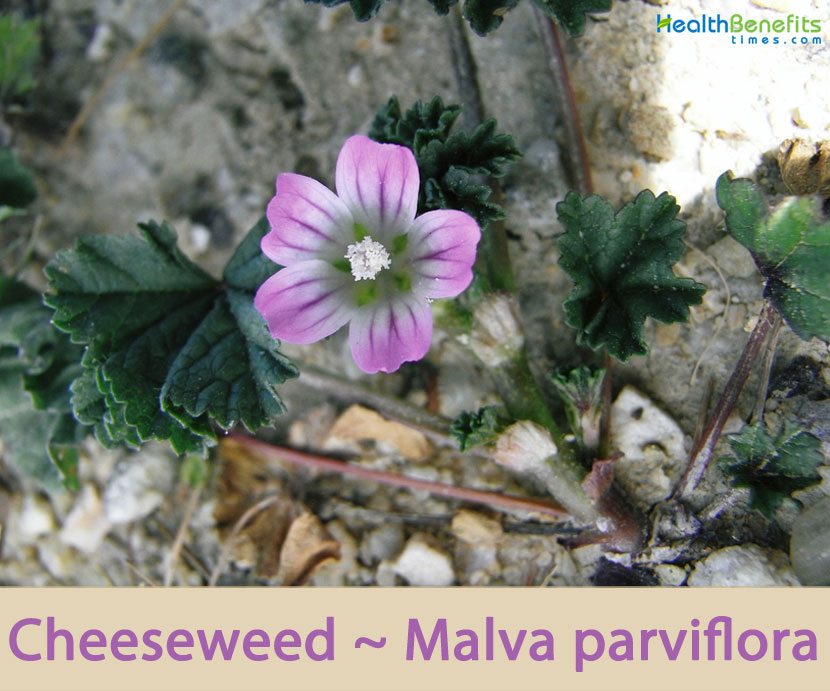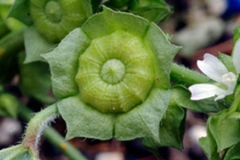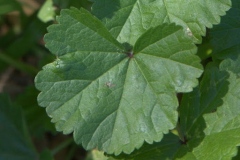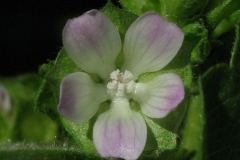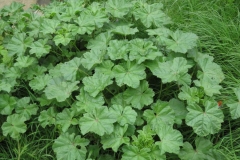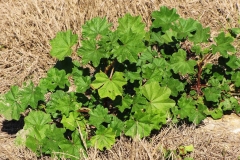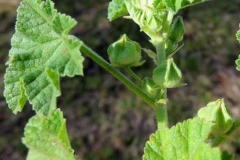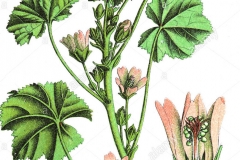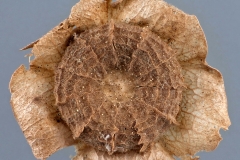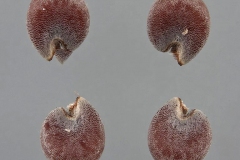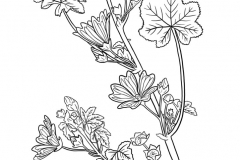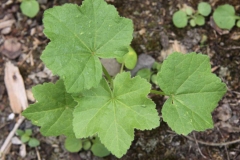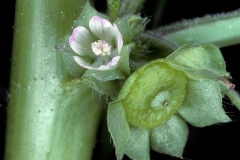| Cheeseweed Quick Facts | |
|---|---|
| Name: | Cheeseweed |
| Scientific Name: | Malva parviflora |
| Origin | Europe, western and central Asia and northern Africa |
| Colors | Green when young turning to brown when ripe |
| Shapes | Schizocarp (a dry fruit which splits into individual carpels). It is 7-8 mm in diameter and separates into 8-12, 1 seeded mericarps. The schizocarp is disc-shaped surrounded by the calyx |
| Health benefits | Antidepressant Properties, Improves Respiratory Function, Relieves Pain, Treats Cough, Asthma, and Bronchitis, Skin Care, Anti-aging Properties, Oral Health, Prevents Prostate Cancer, Relieves Constipation, Prevents Urinary Tract Infections, Boosts Digestion, Boosts Immunity, Anti-Inflammatory Properties |
| Name | Cheeseweed |
|---|---|
| Scientific Name | Malva parviflora |
| Native | Europe, western and central Asia and northern Africa, and introduced widely through cultivation. It regularly escapes cultivation in North America, but is rarely encountered in New England, where it has been collected only in Vermont. |
| Common Names | Egyptian mallow, cheese weed, cheesewood, least mallow, little mallow, ring-leaf mallow, small-flower mallow, whorl-flower mallow, whorled mallow, Cheeseweed mallow, Small-flowered mallow, Small-flowered marshmallow |
| Name in Other Languages | Afrikaans: Kasies, Pampoentijies Albanian: Mullagë Arabic: Khubeizah, khabazat saghirat al’azhar (خبازة صغيرة الأزهار), khobbiza Bengali: Nāpā śāka (নাপা শাক) Brazil: Malva-de-cheiro Catalan: Malva de flor petita Chinese: Xiǎohuā jǐn kuí (小花錦葵) Croatian: Sitnocvjetni sljez Czech: Sléz malokvětý Danish: Småblomstret katost Dutch: Kleinbloemig kaasjeskruid, kleinbloemkaasjeskruid English: Egyptian mallow, Least Mallow, Small-flowered mallow, Cheeseweed, Cheeseweed mallow, Little mallow, Ring-leaf mallow, Small-flower mallow, Small-whorl mallow, Whorl-flower mallow, Whorled mallow, Alkali mallow, Country mallow, Small whorled cheeseweed, Small-whorled mallow, Small mallow, pink cheeseweed Estonian: Egiptuse kassinaeris Finnish: Myllymalva French: Mauve parviflore, Mauve d’Egypte, Mauve à petites fleurs, mauve à petits fruits German: Kleinblütige Malve, kleine Malve, kleine Hebrew: Chelmit ketannat-perachim, חֶלְמִית קְטַנַּת-פְּרָחִים Hindi: Panirak, Soncheli, Golio, Guragped Hungarian: Mályva Italian: Malva minore, malva selvatica Japanese: Usagiaoi (ウサギアオイ) Korean: Ae gi a uk (애기아욱) Netherlands: Kaasjeskruid, kleinbloem Norwegian: Møllekattost Persian: پنیرک گلریز Polish: Ślaz drobnokwiatowy Portuguese: Malva, Malva-crespa, Malva-de-botica, Malvaísco, malva-de-flor-pequena, malva-pequena, malva-de-cheiro Punjabi: Nanna,Geogisag,Sonchal Quechua: Urqu rup’u Slovak: Slez Spanish: Malvilla menor, Malva de Castilla, Malva de campo, malva, Quesillo, Quesitos, malva de flor chica, hierba de queso, malva de flor menuda, malva de flor pequeña, malva menor, malva grande Swedish: Kvarnkattost, Myllymalva Turkish: Mülkek Welsh: Hocys Bach, Hocysen Fach, Hocysen Leiaf |
| Plant Growth Habit | Annual or short-lived perennial herbs |
| Growing Climates | Fields, waste land, waste places, in sheep yards, around farm buildings, closed yards, watercourses, roadsides, forest edge, ditches, other disturbed open areas, grasslands, woodland, on heavily grazed grassland, on stony hills and at edges of ponds and lakes |
| Soil | Occur on all soil types |
| Plant Size | Up to 50 cm high |
| Root | Often branched at the base, branches sparsely pubescent with patent simple and stellate hairs when young, later becoming glabrescent |
| Leaf | Circular and 8-10 cm in diameter. The base of the leaf is cordate (heart shaped with a notch at the base), margins are crenate (a margin with shallow, rounded teeth) and it is sparsely pubescent |
| Flowering season | March-August |
| Flower | Flowers have 5 petals that are about 4-6 mm long, white or pink in color, and twisted in the bud. The stamens are numerous with filaments fused in a column surrounding the branched style. There are as many branches of the styles as carpels. Malva parviflora has 8-12 carpels |
| Fruit Shape & Size | Schizocarp (a dry fruit which splits into individual carpels). It is 7-8 mm in diameter and separates into 8-12, 1 seeded mericarps. The schizocarp is disc-shaped surrounded by the calyx |
| Fruit Color | Green when young turning to brown when ripe |
| Seed | Rounded comma-shaped in outline, prominently notched along margin where hilum occurs, compressed (thickened along the margin opposite the hilum and usually with a rounded, concave area on each face, creating a bilobed cross-section), 1.5–2 mm diameter x 1.2–1.5 mm thick. Surface reddish-brown, finely wrinkled at high magnification |
| Propagation | By Seed |
| Plant Parts Used | Roots, Leaves |
| Health Benefits |
|
Plant Description
Cheeseweed is a prostrate to erect, annual or short-lived perennial herb that normally growing up to 50 cm high that is covered with rather stiff star-like (stellate) hairs and is woody at the base. The plant is found growing in fields, waste land, waste places, in sheep yards, around farm buildings, closed yards, watercourses, roadsides, forest edge, ditches, other disturbed open areas, grasslands, woodland, on heavily grazed grassland, on stony hills and at edges of ponds and lakes. The plant normally occurs on all soil types. The stems are covered with stiff star-like (stellate) hairs and can be erect or ascending (at first spreading horizontally and then becoming erect) and rather fibrous.
Leaves
The leaves are circular and 8-10 cm in diameter. The base of the leaf is cordate (heart shaped with a notch at the base), margins are crenate (a margin with shallow, rounded teeth) and it is sparsely pubescent (with a covering of short, weak, soft hairs). The leaves are palmately veined with 5-7 short triangular lobes. The petiole (leaf stalk) is mostly 1.5-12 cm long and rarely 20 cm.
Flowers
The flowers have 5 petals that are about 4-6 mm long, white or pink in color, and twisted in the bud. The stamens are numerous with filaments fused in a column surrounding the branched style. There are as many branches of the styles as carpels. Malva parviflora has 8-12 carpels. The pedicel (flower stalk) is generally less than 1cm in length at maturity. Outer sepals are linear, 3-4 mm long. Sepal cup is 5-6 mm long, flat in fruit, and 7-9 mm long, fused slightly above the middle. Sepals are triangular, pointed or long-pointed. Petals are as long as or slightly longer than the sepals, white, sometimes with pinkish tips. Flowering normally takes place in between March-August
Fruit
Fertile flowers are followed by schizocarp (a dry fruit which splits into individual carpels). It is 7-8 mm in diameter and separates into 8-12, 1 seeded mericarps. The schizocarp is disc-shaped surrounded by the calyx (sepals of the flower) and are brown when ripe. The sectioned fruit (schizocarp) looks like a sliced wheel of cheese, hence the common name of cheeseweed mallow.
Seeds
Seed is rounded comma-shaped in outline, prominently notched along margin where hilum occurs, compressed (thickened along the margin opposite the hilum and usually with a rounded, concave area on each face, creating a bilobed cross-section), 1.5–2 mm diameter and 1.2–1.5 mm thick. Surface is reddish-brown, finely wrinkled at high magnification.
Health benefits of Cheeseweed
Listed below are some of the popular health benefits of using Cheeseweed
1. Antidepressant Properties
Cheeseweed extract are used in a number of numbing, insomnia, anxiety and stress medications, and even in the anesthetics that dentists use. Various components of the plant help calm the nervous system and encourage a sense of peace and relaxation. Cheeseweed demonstrated the effectiveness of its extract in the treatment of sleep disorders compared to the use of a drug similar to valium.
2. Improves Respiratory Function
Cheeseweed may relieve any chest congestion or a respiratory condition. Cheeseweed can increase expectoration, which helps to clear out the respiratory tracts, but it also calms the throat and glands due to its anti-inflammatory aspects, while also promoting healing and more rapid recovery.
3. Relieves Pain
Chemicals from the Cheeseweed leaves help to speed healing, due to their rich vitamin content, but will also offer certain analgesic properties to the area, decreasing pain and discomfort. This analgesic ability of the Cheeseweed can be used in many ways throughout the body, both internally and externally. This also makes it a popular application in face masks or topical headache remedies.
4. Treats Cough, Asthma, and Bronchitis
Cheeseweed consists of polysaccharides with antiviral and antiseptic properties that help treat respiratory disorders and a chronic dry cough. Active ingredients of the plant help to remove mucus from the throat and have a calming effect in addition to their ability to treat asthma, bronchitis, emphysema, and other respiratory diseases.
5. Skin Care
Anti-inflammatory components of Cheeseweed are effective in treating a variety of skin problems. It is used to soothe rashes, wounds, burns, insect bites and eczema, since the polysaccharides, which nourish and soothe the skin, are also slightly anesthetic.
6. Anti-aging Properties
Cheeseweed extracts in various cosmetic products such as soaps, makeup, and skincare products are rich in components that fight free radicals which damage skin cells and cause wrinkles. Vitamin A gives the skin a radiant and younger look. It is also effective for hair care and is recommended for use in people with fragile hair.
7. Oral Health
Cheeseweed leaves consist of antibacterial and anti-inflammatory components that protect the gums and oral cavity from diseases and infection. Polyphenols present in the plant prevent the development of bacterial plaque by their ability to fight free radicals. Using Cheeseweed tea as a mouthwash may be a natural and effective way to treat the health of the oral cavity regularly.
8. Prevents Prostate Cancer
Cheeseweed is rich in chlorophyll, a green, anti-carcinogenic pigment that cleans our internal organs. It is preventing and healing prostate cancer. Cheeseweed has a substance called beta-sitosterol, which is known for its ability to prevent tumors in the prostate gland. Cheeseweed can be used as a preventative measure for people at risk of developing this cancer.
9. Relieves Constipation
Cheese weed’s polysaccharide mucilage causes relaxation and lubrication of the intestinal walls and better absorption of food. This substance also helps to reduce gastric acidity which causes stomach discomfort. Eating Cheeseweed or consuming it as a tea infusion helps people who suffer from constipation, irritable stomach, and intestinal cramps and need a soothing supplement.
10. Prevents Urinary Tract Infections
Cheeseweed is an excellent alternative to treat burning sensations, frequency, and urgency in urination and pain in the lower abdomen because it has an anti-inflammatory component. It is a diuretic that helps clean up waste from the kidneys and prevents the development of stones in them.
11. Boosts Digestion
Cheeseweed may regulate the digestive system and relieve any strain on that organ system.
12. Boosts Immunity
Cheeseweed can boost the immune system by preventing bacterial infections and other foreign agents to affect those wounded areas.
13. Anti-Inflammatory Properties
Cheeseweed can be very effective for reducing inflammation and swelling, while also stimulating more rapid healing.
Traditional uses and benefits of Cheeseweed
- The whole plant is emollient and pectoral.
- It can be used as a poultice on swellings, running sores and boils.
- They are used in the treatment of coughs and ulcers in the bladder.
- Decoction of the roots or leaves has been used as a hair rinse to remove dandruff and to soften the hair.
- It is used for the treatment of wounds and other related ailments by the Xhosa people of South Africa.
- It is also known to be used in the treatment of inflamed purulent wounds, swellings, bruises, and broken limbs.
- Ointment prepared from the plant provided relief from bee and wasp stings.
- An ointment made with salt and honey cured ulcers of the eye.
- Ointment made with oil helped burns and skin inflammations.
- In the 19th century, it was recommended as an excellent demulcent in coughs and irritations of the air passages in The United States.
- The soothing mucilage found in its leaves is useful in cough syrups.
- Some still use Cheeseweed extract for coughs and colds and for irritations of the alimentary canal.
- Seeds are used in the treatment of coughs and ulcers in the bladder.
- Decoction of the roots or leaves has been used as a hair rinse to remove dandruff and to soften the hair.
- It can cure sleeping problem and respiratory illnesses.
- It can also relieve your pain; treat a cough, asthma, and bronchitis too.
- It also treats infections, skin sores, and burns.
- It has some anti-aging properties that help to improve your skin.
- It protects the gums from infections, prevents prostate cancer, and the most important thing is that it can help treat kidney stones and urinary tract infections common in most people because of the lack of pure and mineral full water.
- It is also used to heal wounds.
- Its wood is used to make toothbrushes.
- It is used to make dyes and also treat acne.
- Lotion made from the leaves is used to treat bruises and broken limbs.
- Leaves of M. parviflora are used for drawing swollen, inflamed purulent wounds.
- parviflora possesses antibacterial, anti-diabetic, antifungal, hepato protective, neuro-protective, anti-irritant, antioxidant, anti-ulcerogenic, analgesic and other activities.
- It has been widely used in many parts of the world for curing various diseases.
- People used a poultice made from the whole plant parts of the plant to treat boils, inflamed purulent wounds and swellings.
- Hot poultice of leaf is used to treat wounds and swellings and tea of the leaf is taken as a nervine tonic and used as a taenicide and for profuse menstruation.
- Tea of the leaf is used for treating dry, irritative, cough and bronchitis.
- Tea of the leaf is also used to clean out the mother’s system after childbirth.
- Seeds are demulcent, used to treat cough and ulcers in the bladder.
- Traditional healers and herbalists use dried powder or an infusion made from leaves and roots to clean wounds and sores.
Culinary uses
- Leaves can be consumed raw or cooked as a potherb.
- It has a mild pleasant flavor they make a very acceptable alternative to lettuce in salads.
- Immature seeds can be consumed raw or cooked.
- They are used to make a creamed vegetable soup that resembles pea soup.
- Few leaves are also added for coloring.
- Seeds have a pleasant nutty flavor, though they are too small for most people to want to collect in quantity.
- Romans ate the seed and boiled the leaves like cabbage.
- Children traditionally have eaten the green immature fruits of malva.
- Raw fruits are crisp and slightly sweet and are good for salads, pickling, or soups.
- People of many countries eat young tender shoots and leaves as a potherb, salad green, or soup vegetable.
- Leaves and stems of dried young plants can be brewed into tea.
Other Facts
- The seed contains up to 18% of fatty oil.
- Cream, yellow and green dyes can be obtained from the plant and the seed heads.
- Decoction of the roots or leaves has been used as a hair rinse to soften the hair.
Precautions
- Leaves of some species tend to concentrate high levels of nitrates in their leaves.
- Leaves are perfectly wholesome at all other times.
- When grown on nitrogen-rich soils, cheeseweed tends to concentrate high levels of nitrates in its leaves.
- Large doses of Cheeseweed, however, can be used as a laxative and in turn cause diarrhea.
References:
https://www.itis.gov/servlet/SingleRpt/SingleRpt?search_topic=TSN&search_value=21838#null
http://www.hear.org/pier/species/malva_parviflora.htm
https://npgsweb.ars-grin.gov/gringlobal/taxon/taxonomydetail?id=90031
https://pfaf.org/USER/Plant.aspx?LatinName=Malva+parviflora
https://www.flowersofindia.net/catalog/slides/Least%20Mallow.html
http://www.theplantlist.org/tpl/record/kew-2503517
https://indiabiodiversity.org/species/show/264278
https://wssa.net/wp-content/themes/WSSA/WorldOfWeeds/cheeseweed.html
https://gd.eppo.int/taxon/MALPA
https://en.wikipedia.org/wiki/Malva_parviflora
https://www.cabi.org/isc/datasheet/1981
https://tropical.theferns.info/viewtropical.php?id=Malva+parviflora
https://plants.usda.gov/home/plantProfile?symbol=MAPA5


